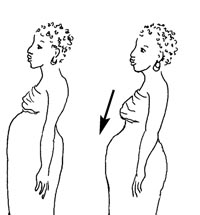

There is no way to be sure when a woman's labour will begin, but there are some signs that it will start soon. Babies often drop lower in the mother's belly about 2 weeks before birth, which is known as lightening; commonly, mothers feel that the baby is no longer lying 'high' in the abdomen, and not pushing her stomach upwards. If she has had babies before, this baby may not drop until labour begins.
Other signs may happen only a day or two before labour starts. The mother's stool may change, or a little show (bloody mucus) may come out of the vagina. Sometimes, the bag of waters leaks or breaks (premature rupture of fetal membranes — PROM) before labour begins.
Recognising true labour isn't an easy task for the mother, particularly if this is her first baby. She may come repeatedly to the health facility or call for you, assuming that minor complaints are the start of true labour. Counselling the mother and her family on birth preparedness is part of focused antenatal care. When you counsel her on how to recognise true labour and what actions to take, make sure you use simple and easily understandable language and clearly demonstrate what she will feel on her abdomen. Your role is very important, first to minimise the mother's anxiety about the labour, and second to reduce her unnecessary costs and time spent visiting the health facility for false labour or minor complaints.
Tell her that true labour is:

Demonstrate on her abdomen: